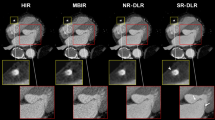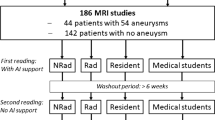Abstract
Automatic in vivo segmentation of multicontrast (multisequence) carotid magnetic resonance for plaque composition has been proposed as a substitute for manual review to save time and reduce inter-reader variability in large-scale or multicenter studies. Using serial images from a prospective longitudinal study, we sought to compare a semi-automatic approach versus expert human reading in analyzing carotid atherosclerosis progression. Baseline and 6-month follow-up multicontrast carotid images from 59 asymptomatic subjects with 16–79 % carotid stenosis were reviewed by both trained radiologists with 2–4 years of specialized experience in carotid plaque characterization with MRI and a previously reported automatic atherosclerotic plaque segmentation algorithm, referred to as morphology-enhanced probabilistic plaque segmentation (MEPPS). Agreement on measurements from individual time points, as well as on compositional changes, was assessed using the intraclass correlation coefficient (ICC). There was good agreement between manual and MEPPS reviews on individual time points for calcification (CA) (area: ICC; 0.85–0.91; volume: ICC; 0.92–0.95) and lipid-rich necrotic core (LRNC) (area: ICC; 0.78–0.82; volume: ICC; 0.84–0.86). For compositional changes, agreement was good for CA volume change (ICC; 0.78) and moderate for LRNC volume change (ICC; 0.49). Factors associated with LRNC progression as detected by MEPPS review included intraplaque hemorrhage (positive association) and reduction in low-density lipoprotein cholesterol (negative association), which were consistent with previous findings from manual review. Automatic classifier for plaque composition produced results similar to expert manual review in a prospective serial MRI study of carotid atherosclerosis progression. Such automatic classification tools may be beneficial in large-scale multicenter studies by reducing image analysis time and avoiding bias between human reviewers.


Similar content being viewed by others
References
Redgrave J, Lovett JK, Gallagher PJ, Rothwell PM (2006) Histological assessment of 526 symptomatic carotid plaques in relation to the nature and timing of ischemic symptoms—the Oxford plaque study. Circulation 113:2320–2328
Narula J, Nakano M, Virmani R, Kolodgie FD, Petersen R, Newcomb R, Malik S, Fuster V, Finn AV (2013) Histopathologic characteristics of atherosclerotic coronary disease and implications of the findings for the invasive and noninvasive detection of vulnerable plaques. J Am Coll Cardiol 61:1041–1051
Saam T, Ferguson MS, Yarnykh VL, Takaya N, Xu D, Polissar NL, Hatsukami TS, Yuan C (2005) Quantitative evaluation of carotid plaque composition by in vivo MRI. Arterioscler Thromb Vasc Biol 25:234–239
Wasserman BA, Smith WI, Trout HH, Cannon RO, Balaban RS, Arai AE (2002) Carotid artery atherosclerosis: in vivo morphologic characterization with gadolinium-enhanced double-oblique MR imaging–initial results. Radiology 223:566–573
Trivedi RA, U-King-Im J, Graves MJ, Horsley J, Goddard M, Kirkpatrick PJ, Gillard JH (2004) Multi-sequence in vivo MRI can quantify fibrous cap and lipid core components in human carotid atherosclerotic plaques. Eur J Vasc Endovasc Surg 28:207–213
Cappendijk VC, Cleutjens KBJM, Kessels AGH, Heeneman S, Schurink GWH, Welten RJTJ, Mess WH, Daemen MJAP, van Engelshoven JMA, Kooi ME (2005) Assessment of human atherosclerotic carotid plaque components with multisequence MR imaging: initial experience1. Radiology 234:487–492
Sun J, Balu N, Hippe DS, Xue Y, Dong L, Zhao X, Li F, Xu D, Hatsukami TS, Yuan C (2013) Subclinical carotid atherosclerosis: short-term natural history of lipid-rich necrotic core—a multicenter study with MR imaging. Radiology 268:61–68
Wagenknecht L, Wasserman B, Chambless L, Coresh J, Folsom A, Mosley T, Ballantyne C, Sharrett R, Boerwinkle E (2009) Correlates of carotid plaque presence and composition as measured by MRI: the atherosclerosis risk in communities study. Circ Cardiovasc Imaging 2:314–322
Zhao XQ, Dong L, Hatsukami T, Phan BA, Chu B, Moore A, Lane T, Neradilek MB, Polissar N, Monick D, Lee C, Underhill H, Yuan C (2011) MR imaging of carotid plaque composition during lipid-lowering therapy: a prospective assessment of effect and time course. J Am Coll Cardiol Imaging 4:977–986
Zhao XQ, Hatsukami TS, Hippe DS, Sun J, Balu N, Isquith DA, Crouse JR III, Anderson T, Huston J III, Polissar N, O’Brien K, Yuan C (2014) Clinical factors associated with high-risk carotid plaque features as assessed by magnetic resonance imaging in patients with established vascular disease (from the AIM-HIGH Study). Am J Cardiol 114:1412–1419
Kwee RM, van Oostenbrugge RJ, Prins MH, Ter Berg JW, Franke CL, Korten AG, Meems BJ, van Engelshoven JM, Wildberger JE, Mess WH, Kooi ME (2010) Symptomatic patients with mild and moderate carotid stenosis: plaque features at MRI and association with cardiovascular risk factors and statin use. Stroke 41:1389–1393
Liu F, Xu DX, Ferguson MS, Chu BC, Saam T, Takaya N, Hatsukami TS, Yuan C, Kerwin WS (2006) Automated in vivo segmentation of carotid plaque MRI with morphology-enhanced probability maps. Magn Reson Med 55:659–668
Adame IM, van der Geest RJ, Wasserman BA, Mohamed MA, Reiber JH, Lelieveldt BP (2004) Automatic segmentation and plaque characterization in atherosclerotic carotid artery MR images. MAGMA 16:227–234
Clarke SE, Beletsky V, Hammond RR, Hegele RA, Rutt BK (2006) Validation of automatically classified magnetic resonance images for carotid plaque compositional analysis. Stroke 37:93–97
van’T Klooster R, Naggara O, Marsico R, Reiber JH, Meder JF, van der Geest RJ, Touze E, Oppenheim C (2012) Automated versus manual in vivo segmentation of carotid plaque MRI. Am J Neuroradiol 33:1621–1627
Hofman JM, Branderhorst WJ, Ten EH, Cappendijk VC, Heeneman S, Kooi ME, Hilbers PA, ter Haar RB (2006) Quantification of atherosclerotic plaque components using in vivo MRI and supervised classifiers. Magn Reson Med 55:790–799
Sun J, Zhao XQ, Balu N, Hippe DS, Hatsukami TS, Isquith DA, Yamada K, Neradilek MB, Canton G, Xue Y, Fleg JL, Desvigne-Nickens P, Klimas MT, Padley RJ, Vassileva MT, Wyman BT, Yuan C (2015) Carotid magnetic resonance imaging for monitoring atherosclerotic plaque progression: a multicenter reproducibility study. Int J Cardiovasc Imaging 31:95–103
Kerwin WS, Xu D, Liu F, Saam T, Underhill HR, Takaya N, Chu BC, Hatsukami TS, Yuan C (2007) Magnetic resonance imaging of carotid atherosclerosis: plaque analysis. Top Magn Reson Imaging 18:371–378
Takaya N, Cai JM, Ferguson MS, Yarnykh VL, Chu BC, Saam T, Polissar NL, Sherwood J, Cury RC, Anders RJ, Broschat KO, Hinton D, Furie KL, Hatsukami TS, Yuan C (2006) Intra- and interreader reproducibility of magnetic resonance imaging for quantifying the lipid-rich necrotic core is improved with gadolinium contrast enhancement. J Magn Reson Imaging 24:203–210
Cai JM, Hatsukami TS, Ferguson MS, Kerwin WS, Saam T, Chu BC, Takaya N, Polissar NL, Yuan C (2005) In vivo quantitative measurement of intact fibrous cap and lipid-rich necrotic core size in atherosclerotic carotid plaque: comparison of high-resolution, contrast-enhanced magnetic resonance imaging and histology. Circulation 112:3437–3444
Davison AC, Hinkley DV (1997) Bootstrap methods and their application. Cambridge University Press, Cambridge
Fleiss J (1986) Reliability of measurement. In: Fleiss J (ed) The design and analysis of clinical experiments. Wiley, New York, pp 1–31
Kerwin WS, Liu F, Yarnykh V, Underhill H, Oikawa M, Yu W, Hatsukami TS, Yuan C (2008) Signal features of the atherosclerotic plaque at 3.0 Tesla versus 1.5 Tesla: impact on automatic classification. J Magn Reson Imaging 28:987–995
Touze E, Toussaint JF, Coste J, Schmitt E, Bonneville F, Vandermarcq P, Gauvrit JY, Douvrin F, Meder JF, Mas JL, Oppenheim C (2007) Reproducibility of high-resolution MRI for the identification and the quantification of carotid atherosclerotic plaque components: consequences for prognosis studies and therapeutic trials. Stroke 38:1812–1819
Virmani R, Kolodgie FD, Burke AP, Farb A, Schwartz SM (2000) Lessons from sudden coronary death—a comprehensive morphological classification scheme for atherosclerotic lesions. Arterioscler Thromb Vasc Biol 20:1262–1275
Takaya N, Yuan C, Chu BC, Saam T, Underhill H, Cai JM, Tran N, Polissar NL, Isaac C, Ferguson MS, Garden GA, Cramer SC, Maravilla KR, Hashimoto B, Hatsukami TS (2006) Association between carotid plaque characteristics and subsequent ischemic cerebrovascular events: a prospective assessment with MRI—initial results. Stroke 37:818–823
Kwee RM, van Oostenbrugge RJ, Mess WH, Prins MH, van der Geest RJ, Ter Berg JW, Franke CL, Korten AG, Meems BJ, van Engelshoven JM, Wildberger JE, Kooi ME (2013) MRI of carotid atherosclerosis to identify TIA and stroke patients who are at risk of a recurrence. J Magn Reson Imaging 37:1189–1194
Underhill HR, Yuan C, Zhao XQ, Kraiss LW, Parker DL, Saam T, Chu B, Takaya N, Liu F, Polissar NL, Neradilek B, Raichlen JS, Cain VA, Waterton JC, Hamar W, Hatsukami TS (2008) Effect of rosuvastatin therapy on carotid plaque morphology and composition in moderately hypercholesterolemic patients: a high-resolution magnetic resonance imaging trial. Am Heart J 155:581–584
Liu W, Balu N, Sun J, Zhao X, Chen H, Yuan C, Zhao H, Xu J, Wang G, Kerwin WS (2012) Segmentation of carotid plaque using multicontrast 3D gradient echo MRI. J Magn Reson Imaging 35:812–819
Cappendijk VC, Heeneman S, Kessels AG, Cleutjens KB, Schurink GW, Welten RJ, Mess WH, van Suylen RJ, Leiner T, Daemen MJ, van Engelshoven JM, Kooi ME (2008) Comparison of single-sequence T1w TFE MRI with multisequence MRI for the quantification of lipid-rich necrotic core in atherosclerotic plaque. J Magn Reson Imaging 27:1347–1355
Wasserman BA, Astor BC, Sharrett AR, Swingen C, Catellier D (2010) MRI measurements of carotid plaque in the atherosclerosis risk in communities (ARIC) study: methods, reliability and descriptive statistics. J Magn Reson Imaging 31:406–415
Acknowledgments
MRI scans were performed as part of a clinical trial funded by Kowa Research Institute.
Conflict of interest
DSH receives grant support from GE Healthcare. DX is a consultant for VPDiagnostics Inc, Seattle, WA. WSK is now affiliated with Presage Biosciences, Seattle, WA. TSH receives research grants from Philips Healthcare. CY receives grant support from Philips Healthcare and is a member of Radiology Medical Advisory Network of Philips Healthcare. The remaining authors report no conflicts of interest.
Author information
Authors and Affiliations
Corresponding authors
Additional information
Taku Yoneyama and Jie Sun have contributed equally to this work.
Rights and permissions
About this article
Cite this article
Yoneyama, T., Sun, J., Hippe, D.S. et al. In vivo semi-automatic segmentation of multicontrast cardiovascular magnetic resonance for prospective cohort studies on plaque tissue composition: initial experience. Int J Cardiovasc Imaging 32, 73–81 (2016). https://doi.org/10.1007/s10554-015-0704-0
Received:
Accepted:
Published:
Issue Date:
DOI: https://doi.org/10.1007/s10554-015-0704-0




